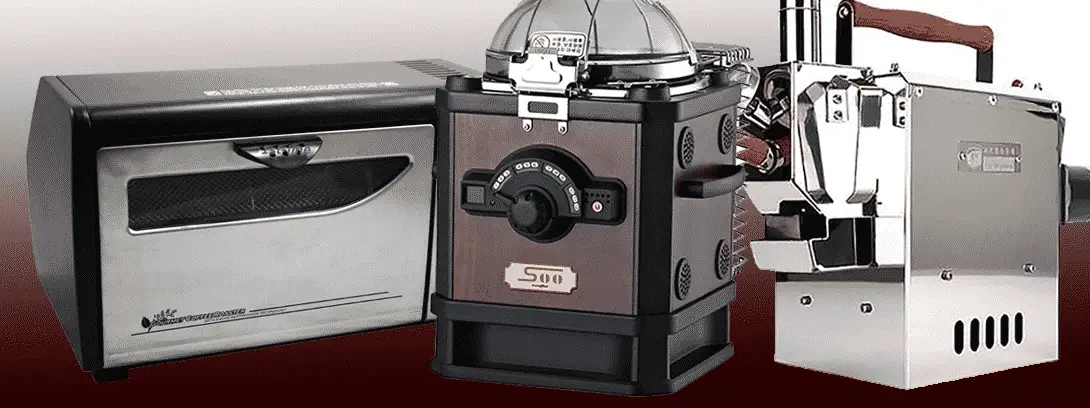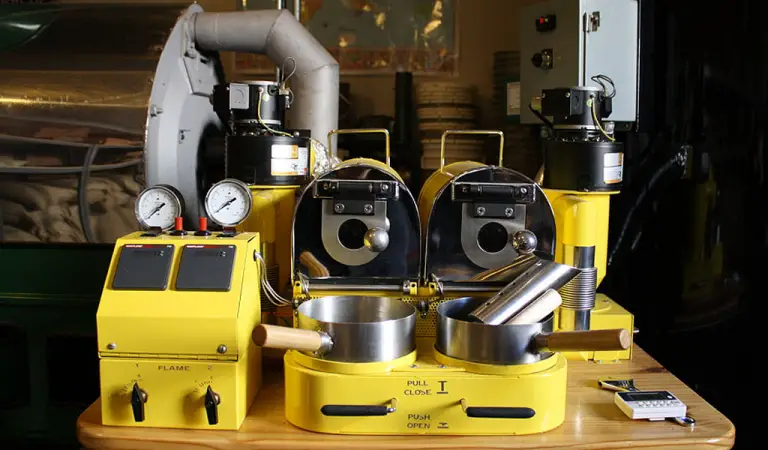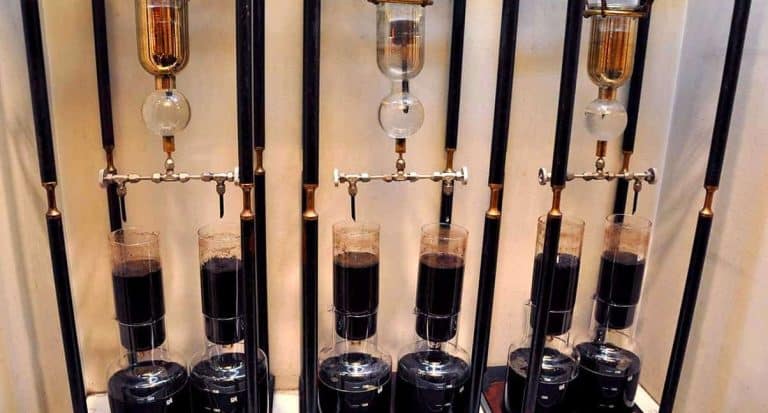3 Great Coffee Roasters Under $550 – and Why They’re the Best
$550 seems to be the price point where serious coffee roasters usually enter the market. There’s a good reason for this. While there are a few very good roasters available in the lower price brackets at $300 and even $150, manufacturers have usually made compromises to keep the price down. In the $550 price range those manufacturing limitations tend to fall away.
For example, at the $300 price range our choice was a manual crank, stripped down Kaldi roaster. At the $150 price point our choice, the Fresh Roast SR 340, lacked heat control. They both produce good coffee but the lack of features requires more effort and sometimes additional cost in accessories.
At the $550 price point, we start to find full featured roasters which come (mostly) with a full complement of roasting accessories and the ability to control the roasting process more.
There’s also quite a long way to the next logical price bracket which is around $800. And if you are prepared to pay that, buyers tend keep going a bit higher and get a higher specced pro-sumer sample roaster that start at about $1000 – $1500.
What we Reviewed
Once again our choice is between a machine for roasters who enjoy the cupping and want to roast without too much fuss and those who jump headlong into the roast profile and get into the nitty gritty of roasting profiles.
The first two roasters, the Behmor 1600 Plus and the Ottimo N-905CR are electric models with a lot of built in automation. They tend to be more automated with built in roasting programs. These are really convenient for the serious coffee aficionado who wants to dial in the perfect roast and keep producing it.
The third option is the Kaldi Home Coffee Roaster Package, which is a downsized version of a professional drum roaster. It demands hands on roasting with an eye on the timer and thermometer and a hand on the gas valve. Unlike the first two options which are more automated, the Kaldi is fully manually controlled. In my book, that’s a good thing.
Skip to reviews:
It offers an infinite range of controls but relies heavily on the operator to turn everything on and off at the correct time. For those with the time and inclination wanting to get into roasting hands-on in a serious way, this is a good coffee roaster choice.
That’s not to say you can’t fine tune the first two roasters. For each home roaster swearing by the Kaldi, you’ll get two more that have roasted incredible coffee on the Behmor and/or the Ottimo. Like most things in the dark arts of coffee roasting, it comes down to personal preference. If it didn’t, we’d all be drinking the same exact coffee roasted in exactly the same way. The cheap over-roasted beans of the main coffee chains comes to mind.
As usual, I would tend to go with the “unplugged” version, the Kaldi. And I’m the first to admit my bias. I like to fiddle and adjust and endlessly tweak the process. My wife tells me that even if I never drank another cup of coffee, I’d still be happy roasting coffee every day. I think she exaggerates…..or maybe she’s not too wrong about me loving the process of roasting as much as the coffee itself. Read on about the others and make up your own minds. They’re all good roasters that can produce really fine coffee.
Our Choice
I liked the KALDI Home Coffee Roaster Package. Although it’s supplied without a burner, it is a great and really versatile drum roaster that is built like an armoured car. It doesn’t have the design polish of the other roasters but I like the stainless gleaming machinery look of it complete with the exposed acorn nuts on the top.
Most importantly, it can produce a range of light to City+ roasts without any issue. The other units I looked at, the Behmor 1600 in particular warned against roasting dark roasts. The mid range electrically heated units tend to have limited power. You would have to get bigger and more expensive to roast dark on a electric unit.
Even with the extra cost associated with providing your own gas burner with the Kaldi (I use my stove top), this unit in my opinion wins hands down. It’s a wolf of a roaster in sheep’s clothing and you’ll find it will not limit your roasting aspirations in the long run.
And, the Kaldi Package comes with all you need including the feed hopper, chaff tray, thermometer with mount and sampler.
It’s built like a tank and so simple that very little can go wrong. It’s money well spent on a roaster that will serve you well for many years or until you outgrow it.
CBR rating: 4.5/5
1. Behmor 5400 1600 Plus
Roaster Type: Drum roaster | Capacity: 500g (1 lb) | Smoke suppression: Built-in afterburner | Heat: electric

The Behmor roasters have been around for years and the 1600 Plus is the latest model which makes minor improvements on the last. The company has a reputation of being very responsive to user input and continually incorporates real improvements into their products.
Many owners have developed a sort of love-hate relationship with their Behmors, battling to overcome the built in safety and engineering limitations and at the same time roasting great coffee.
In the end, most manage to get the hang of it, find workarounds for the quirky things and consistently produce fine roasted coffee beans. It’s a reliable well reviewed unit. If you respect the built in limitations and find the workarounds for those you don’t like, this is a very competent home coffee roaster.
What I liked
- Roasts evenly
- Good build quality
- Has manual override (a bit cumbersome)
- Good customer service record
- Built in afterburner to reduce smoke
- Reliable mechanics
What I didn’t like
- Safety mechanisms aggressive and cumbersome
- Struggles to achieve first crack on larger batches
- Overly complicated controls
- Difficult to hear 2nd crack
- Chaff collector screen reduces visibility
- Inefficient and slow cooling
The Behmor 5400 1600 is a roaster that’s been on the market for a number of years. The manufacturer states that it is NOT for roasting very dark roasts. It’s not designed for it so, you’ll avoid a whole lot of frustration if you avoid doing it. Don’t buy it if you like city plus and french/vienna roasts.
You can check out current pricing on Amazon.
Build and design
The Behmor 1600 Plus is a barrel roaster encased in a microwave type housing with a front access door that hinges on the bottom. The drum is loaded sideways through the front door.
There is a chaff collection unit that then loads in after the drum which is L shaped and sits under and in front of the drum, between the door viewing panel.
The drum is driven by an electrical motor and the heating units are electrical heater bars that are mounted to the inside of the back wall. All in all I find the Behmor to be a compact logically laid out design which is quite easy to load and clean. It fits in nicely in any kitchen with it’s metal case with nicely rounded edges and falls squarely into the category of an appliance roaster.
It’s a well tested design so it’s strengths and limitations are well known in the roasting community. Once you get the hang of the quirks and find your way to overcome them, you will be able to consistently produce good quality coffee. I find control panel is a bit complicated and the safety mechanisms are overly intrusive.
A nice addition is the smoke reduction afterburner built into the unit. This allowed me to to roast indoors without too much smoke. It’s not perfect – but it is a huge help in reducing much of the smoke produced.
The big question with this roaster is… are putting up with the limitations worth it? I’ll go through what I found. YMMV.
Issues
There are a few niggly issues I found which quite honestly one expects from most roasters as there is and never will be the “perfect” roaster for all.
I found the glass viewing panel in the front to be a bit too small. And on top of it, the chaff collector screen is mounted behind it so it further reduced visibility. The result is that it is difficult to inspect the beans during roasting and I had to roast “seat-of-the pants” while relying mostly on the sound and smell. It’s also difficult to hear 2nd crack over the mechanical motor and fan noise.
The heating elements are electric are not as responsive as gas and lag a bit. The lag impacts on the cooling cycle too as residual heat seems to remain in the heating elements during the start of the cooling cycle. This slow cooling can cause the beans to bake after the roasting cycle is completed. The manufacturer even suggests you can open the front door to improve cooling efficiency. The problem with this is that the chaff starts to blow out the front of the unit but it’s no too bad.
Awkward safety system
By far my biggest issue with this roaster is the aggressive (legal department) designed safety override. Commendably, it’s meant to turn off the roaster when temperatures get too high but I found it intrusive and sometimes annoying.
The problem I found is that when roasting over ¼ lb and the roaster can get too hot and shut down. Also, the timer can run for up to 30 minutes but after 12 minutes it will beep and you are expected to press a button to override the shutdown to continue.
This system was definitely designed by a someone with an eye on a liability claim and not on customer usability. It’s asking, “do you really want to roast for 30 minutes?” I suppose it’s a way of making sure you stay around while the unit roasts.
Now the real safety problems starts if you don’t press the button. The drum stops completely as a “safety” measure. The beans closest to the hot heating elements are now stationary get really hot and can start to smoulder or potentially catch fire before the elements have cooled down sufficiently. It’s the same as turning the power button off during a roast, something the manual warns against doing in order to prevent a fire.
Work a way around these measures, or get used to them, and you will be able to roast decent coffee on this roaster. With most coffee roasting machines in this price bracket having some limitations, it’s just something you will have to learn to deal with.
Control
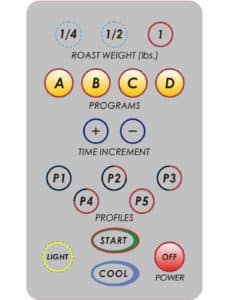
The unit has a membrane control panel on the right of the front door just below a digital readout. It’s broken down into the following sections – from top to bottom.
Roast Weight ¼, ½, 1 pound
This sets the weight of green coffee beans to be roasted and system on switch. One press of each of the weight buttons also sets a default roasting program for each of the weights.
A B C D Programs
This allows you to select a roast time directly associated with the weight chosen. Each would result in a darker roast. A is the default with B, C and D each roasting longer.
Time Increments
These up and down arrow buttons allow you to add or subtract time to each roast program before or during the roast cycle. Each press adds or subtracts 10 seconds.
P1 P2 P3 P4 P5 P6 = heat power

This controls how much heat is applied to the beans. P1 is the most heat and the fastest roast time. P5 is the least heat and the longest roast time.
Here are the P settings described in the user manual.
Profile P1- Hard Bean (Quick Start default) (13:30 ½ lb roast time)
Profile P2 – Hard Bean (a bit longer than P1) (14:30 ½ lb roast time)
Profile P3 – Soft bean/low grown/ espresso blends (15:30 ½ lb roast time)
Profile P4 – Soft bean/ low grown or espresso blends (16:30 ½ lb roast time)
Profile P5- Hawaiian/ Island Coffees- City/City+ (17:30 ½ lb roast time)
Start
As it says-starts the roasting cycle.
Cool
Allows the user to stop a roast at any time and
begin cooling the beans
Light
Light switch for viewing
OFF
Switches off all roasting.
The manufacturer warns against pressing this during a roast cycle unless in an emergency. The say it can “lead to excessive smoke and possibly create a fire hazard”.
It’s all understandable when it’s broken down like this but you have to go through them an memorize to use the roaster. I found I selected a program I liked and tended to stay with it, not using all the other options.
Roasting
Here’s a summary of the roasting process with the Behmor.
- Place the desired amount of green coffee beans in the roasting cylinder and close the access panel. Check the clasp is secure. It can be a bit finicky I found.
- Insert the roasting cylinder in the roaster making sure the square drive peg is inserted in the motor drive. Place the round axle on the other side into the rest bracket. You may need to to rotate the drum to make sure the square peg mates properly with the drive.
- Insert the chaff tray. You need to press the spring loaded handle down before sliding it into place and then release. Make sure it’s installed correctly and doesn’t interfere with the rotation of the cylinder.
Close the front access door. - Select the roasting program and press the START button. You can choose to end the roast at any time by pressing the COOL button.
Here’s a great video showing the roasting process.
Some things to watch for with the Behmor.
You should bear in mind that the beans will be hotter than the displayed temperature reading and take it into account. The beans are in the drum between the heating element at the back and the thermometer sensor in the front of the unit.
At a point in the timer cycle of the roast (about 75% of the time), the safety system beep and start a countdown. You need to cancel the countdown or the roaster will stop prematurely and give you under roasted beans. Once you get used to this, it becomes almost automatic although I still catch myself mumbling something in frustration each time this happens.
A nice feature is the self cleaning cycle. It’s basically and empty ½ lb roasting cycle with a cooling cycle and does clear some of the collected gunk in the roaster.
The Verdict
The Behmor 1600 Plus can be a simple reliable and straightforward roaster once you get over the quirks. It is limited to not roast dark roasts and the heat being electric tends to be a bit laggy.
It’s a bit difficult to use at first but when you arrive at a preferred roast method it does roast a surprisingly good roast. It takes a bit of commitment and patience but once you get the hang of it it does great.
Specifications:
Height: 9″
Width: 15.2″
Depth: 9″
Weight: 22.4 pounds
Power Supply: 120V
Watts: 1600
Warranty: 12 Month Limited Warranty
Link to manufacturer’s data sheet.
Check current pricing for the Behmor 1600 Plus on Amazon.
2. ICOFFEE (OTTIMO) N-905CR HOME COFFEE ROASTER
Roaster Type: Hot air roaster | Capacity: 150g (x lb) | Smoke suppression: Afterburner | Heat: 220v Electric head/fan driven

The ICoffee N905-CR is a self contained counter-top appliance style coffee maker from Korea. The design concept is similar to a hot air popcorn maker but it’s designed for coffee roasting temperatures. It is of course much more rugged and designed to achieve the high roasting temperatures needed for coffee roasting.
A really great feature of the roaster is the built in afterburner which eliminated about 90% of the smoke and fumes. It’s a nicely designed well built, self contained unit which is the marketed as the ultimate appliance roaster. It’s a simple and convenient unit but because of the set and forget nature, is not very versatile. There is one setting dial numbered from 1 to 9 which represent roast darkness, one being the darkest.
This video gives a great demonstration of how easy it is to roast with the N905.
If you live in the US you need to be aware that this is a 220v only roaster. You may need to use a voltage up-converter to use it with 120v. You would need one rated to handle 1100W which will add about $80 to the cost of the roaster so keep that in mind.
What I liked:
- Low noise
- Smoke reduction afterburner
- Good visibility
- Unique antique wood design
- Chaff collector
- S Blade paddle design for roast uniformity
- 9 roast level dial
- Coffee drum clip on handle
- Heater is direct heating system like in Rice cooker
What I didn’t like:
- Only 220V, need to purchase a voltage up-converter
- Cooling is inefficient – fan a bit undersized – heat buildup
- By time remove beans to cooler, beans progressed in roast – danger of burning.
- No separate fan and heat controls, just roasting time
- Tends to work better with smaller roast samples
- Imported, no local service
- Overheating protection can be finicky
- Optional extra cooler, pretty but is under-powered
Build and design
The I-Coffee roaster has a unique afterburner system mounted on the rear of the machine. It’s designed to safely remove most of the smoke produced when roasting coffee beans. It does this by burning any particles left in the smoke at extremely high temperatures.
This means that the roaster can be used indoors in a well ventilated room. I would suggest under the kitchen range hood.
When using the bean cooling attachment, I found that some smoke can escape when transferring the beans to the cooler. It’s noticeable but not a major amount. I also found the chaff collection system in the roaster to be extremely efficient and easy to clean.
Control and Roasting
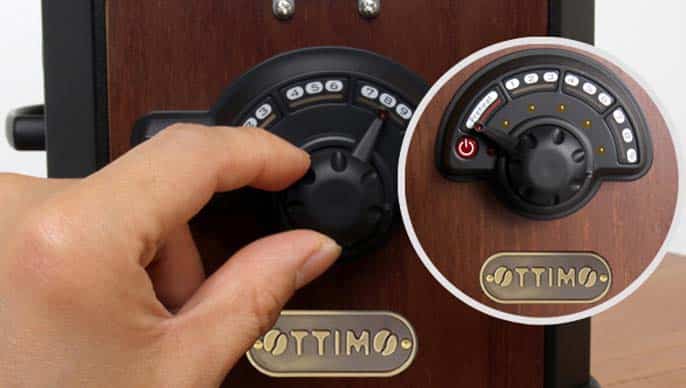
The controls are quite simple with an on-off switch, and a rotary dial with preheat and 12 roasting levels. Level 1 roasts for 19 minutes and Level 12 for about 30 minutes. Here’s a brief explanation about roasting:
- Add the required amount of green coffee.
- Preheat Phase: Turn the dial to the preheat – this phase takes 3 minutes. The LED timer display will show a spinning graphic.
- Roasting Phase: When the 3 minutes pre-heat phase ends the machine will beep. The LED timer will counting down the roasting phase. At the dial setting of 12 it will start counting down from 27 minutes.
- Cool Down Phase: When the roast timer reaches the end of the roast time, the machine will beep and a LED light will flash and the cool cycle will begin. The temperature will gradually decline.
The Verdict:
This is a good set and forget appliance type roaster. It looks great in any kitchen and is built and designed well. If anything, I found the cooler a bit underpowered. It’s a very unobtrusive design which it’s very quiet and compact.
Check prices on the N950CR on Amazon.
Also, if you are in the US, you would need to buy an upconverter with at least 1100W capacity and possibly more if you don’t have a suitable 220V outlet. They can be a bit bulky but could be placed under a counter.
You can check prices of voltage converters on Amazon.
Specifications:
Height: 24cm
Width: 33cm
Depth: 30.5cm
Weight:6.3kg
Power Supply: 220V (upconverter required in USA)
Watts: 1100W
3. KALDI HOME COFFEE ROASTER PACKAGE
Roaster Type: Drum Roaster | Capacity: 200g (7oz.) | Smoke suppression: None | Heat: Gas Burner(not included) | Drive: Electric motor

The Kaldi Home Coffee Roaster is a no-nonsense practical coffee roaster which you will have around for years to come. It’s really well built and has the practical simplicity of a tractor. It’s a workhorse that is easy to take apart and repair if you ever need to clean it or (unlikely) repair it.
It also is conceived as a mini version of a professional drum roaster. The only downside is that you need to provide your own gas heat source which could be as simple as a gas burner ring.
This package version of the Kaldi comes complete with all accessories and all you have to do is fire up the gas burner and start roasting.
I found it takes a bit of trial and error to dial in your perfect roast cycle but it react immediately to changes in temperature. Even a seasoned roaster wouldn’t find the Kaldi limiting and I’ve spoken to some pros who hold this little Korean built roaster in high esteem.
Out of the tree roasters in this price bracket I found could be serious contenders, I found the Kaldi the one I could have around for a long time and not feel I might outgrow as I get better as a roaster.
The one limitation which is that it doesn’t have a separate air control fan like it’s big brother drum roasters. I found that when I roasted it didn’t really make a big difference.
What I liked
- Simple and bullet proof design, Stainless steel construction
- Versatile, responsive,
- Ability to develop complex roast profiles
- Accessories included (except burner)
- Large Capacity for small roaster
- Classic drum roaster
What I didn’t like
- No forced air adjustment, dependent on convection of heat source.
- Analog thermometer is slow to react
- Need to tilt whole machine to empty
- No heat source supplied
This video gives a demonstration how to roast with the Kaldi.
I found the KALDI Home Coffee Roaster to be a well designed roaster that is built like a tank. It’s built exactly like Kaldi’s more expensive models, it just has fewer included accessories. And, of course as with all Kaldi’s you need to provide the heat source.
This roaster will appeal to those that want to endlessly fine tune the roast and want to develop their own special roast profile. This roaster is beautifully built in an industrial way with bolted stainless plates and it screams practicality. It has a really professional look.
There is no pretence in this machine and it arrived without the usual bits of plastic found on the appliance type roasters which are made to blend in.
A great feature is the copper sleeve wrapped around the roasting drum which prevent the flame from a gas burner scorching the beans. This is slipped over the outside of the drum, and it helps to dissipates the heat. The great thing is that this is removable, allowing you to A/B test to see which method you prefer.
I personally like to roast without the sleeve because the roaster becomes more reactive to temperature changes. Without it, the heat doesn’t build up in the copper sleeve which I think can continue to bake the beans when you terminate the roast.
The only drawback I found is that the adjustments on this roaster are made only by increasing or decreasing the heat. There is no ability to adjust air flow independently. That means that you have a smaller margin of error when roasting and it’s a bit more difficult to get the correct temperature. Classic drum roasters have the ability to regulate heat and air flow separately.
This also will make it more difficult to experiment. But most home coffee roasters will tend to find their roast preference and stick with it. So after an initial dialling in period you will easily be able to have consistent results.
I did find the analog thermometer to be a bit slow to react and you might consider fitting a thermocouple one or use a infrared hand held thermometer.
Here’s a popular option on Amazon which sells for less than $30.
Control
As I touched on before, the roasting process is quite simple with the Kaldi roasters. The most difficult part is deciding on the variables like heat, time, drum speed etc.
Unlike the more automated roasters like the Behmor roaster reviewed above, dialing in your roast on the Kaldi will take more time and attention. But what you get is the ability to improve your skills over time and make the fine adjustments needed to nail that “perfect” repeatable roast profile.
Unlike some lower cost hot air roasters, the heat source for the Kaldi is not limited by ventilation of fan size. A gas heat source is the most versatile and economical and the upper limit is almost unlimited. If you want to create really dark roasts you can by simply turning up the heat source and decrease the drum speed as much as you want.
Great When you Get Going
Roasting is straightforward once you get the hang of it. Emptying the roaster however is another thing and may take some getting used to. After turning off the gas, you have to lift the whole unit by the handle and tip out the roasted beans.
This is quite a feat seeing the casing is steel and gets really hot after roasting. I find that despite the wood handle you will need oven gloves or a towel to make sure you come away intact. Once you get used to it, it’s quite easy actually and the simplicity of it all makes a whole lot of sense and dispenses with complex tipping mechanisms and I’m sure keeps the production and sale price down.
Roasting:
I was able to achieve quite a good roast with this roaster and found it can create quite nuanced flavors in the lighter roasts and could roast as dark as I wanted to.
There is of course no smoke suppression technology incorporated so you need to assure your roasting area is ventilated. I found that some of the chaff can fall through to the open flame and creates quite a bit of smoke.
Here’s a breakdown of the roasting process:
- Place the roaster unit securely over the gas burner.
- Attach the chaff collector (if purchased)
- Position the thermometer
- Turn on the gas burner to medium heat
- Turn on the drum motor
- Preheat drum to 350F
- Add beans (use hopper if purchased)
- Remove hopper
- At the 7 minute mark, about 380F degrees, reduce heat and start first crack
- As first crack slows down, increase heat slightly
- If roasting to second crack, adjust burner heat again
- When ready to end the roast quickly turn off the heat, take off chaff collector, lift
The verdict:
This is a versatile, durable roaster for the price and hard to beat if you want the option to get into roasting seriously. I found it as enjoyable to use as some of the more expensive roasters available. Kudos to Kaldi for offering this beautifully built unit.
If you are interested in manual roasting and don’t want to get electronic and computerized, than I’d highly recommend this roaster. It’s really simple. It is designed to sit on a gas burner and you control the flame when you need to.
I can’t see how this product can break down compared to those electronically controlled appliance roasters. Electronics and heat don’t go together well anyway.
The fit and finish on this unit is excellent and it’s ruggedly designed and constructed roaster which should last for years. It’s quiet to run, and if you use your gas cook top you don’t need to supply a separate burner.
You’ll find that as you use this roaster you will start to fine tune your roast profile will get a really good quality roast. Unlike the automatic units you will gain knowledge and understanding about the roasting process with a drum roaster which incidentally is how 98% of the world’s coffee is roasted.
Specifications:
Width: 16cm
Height: 20cm
Depth: 30cm
Weight: 2.8kg
Warranty: Unknown
Check out current pricing for the Kaldi on Amazon
In Conclusion
$550 seems to be the sweet spot for coffee roasting machines for serious home coffee roasters. If you’re like me, you’ll more than likely be casting your wandering eye on bigger and better offerings like a small sample roaster.
The thing I discovered is that most of us tend to prefer a single type of coffee maybe with minor variations. Sample coffee makers are designed for professional roasters who roast a variety of beans and roast types and can be overkill for non commercial roasters.
With offerings like the Kaldi and the Behmor you can produce really good quality roasts that rival and sometimes beat the professional offerings. Sometimes it’s the race driver, and not the car that counts (to a point).
For me, I’ll stick with the Kaldi. I like it’s honesty and it’s lineage and know it will be with me for a very long time. If something breaks, It’s so simple that it can be easily repaired. In the end, coffee roasting is a really simple process when it comes to equipment. The timing and adjustment is where the effort is.
Happy roasting!
You may be interested in these articles:
Can You Find Good Coffee Roasters Under $300? – We Found Two
Are There Usable Coffee Roasters under $150? – We Found the Best


